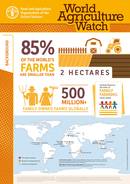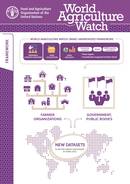Selected publications
This book provides operational guidelines to produce data sets at farm/household level to characterize the diversity of family farms. It is structured around three main sections. The first section presents the World Agriculture Watch (WAW) harmonized analytical framework to characterize the diversity of family farms including a subsection linking farm level with landscape and territorial approaches; The second section provides simple and robust guidance to engage into data production at farm/family (household) level. The third section gives orientations on how to use data sets to help define inclusive and targeted investments strategies and programs to strengthen the productive capacities of family farms using data sets to define typologies and information systems to monitor the effects of the investments.
There are more than 85% of the world’s farms are smaller than 2 hectares and more than 500 million family-owned farms globally. Farms, especially family farms, are highly diverse and generally have limited capital to invest unless they mobilize their own labour force (human capital). Unequal access to assets (natural, physical, social, human or financial) means farmers have varying ability to engage in different types of on- and off-farm activity. To be inclusive, we need to better target investment for all types of farm.
World Agriculture Watch (WAW) offers a comprehensive approach and tools to examine, analyse and monitor agricultural transformation around the world, to identify patterns and drivers of change and assess their impact. While WAW collects data on all types of farm, including industrial agriculture, it pays particularly close attention to family farms, to better tackle the constraints on their development through investment policies.
There are three stages in total for actions of WAW programme, which are CONSOLIDATED FARM DATA, INVESTMENT STRATEGIES, and NATIONAL OBSERVATORIES.
To scale up the initiative, WAW plans to rely on the involvement of numerous interconnected networks and hence will contribute to SDG 17 by strengthening partnerships between CSO, Governments and the private sector. Country projects will be undertaken in 21 countries in which there are around 100 regional observation sites established. WAW also partners with rural producer organizations, national farmer platforms and regional organizations. It works with non-governmental organizations (NGOs) to strengthen the capacity of small support and cooperative groups.






